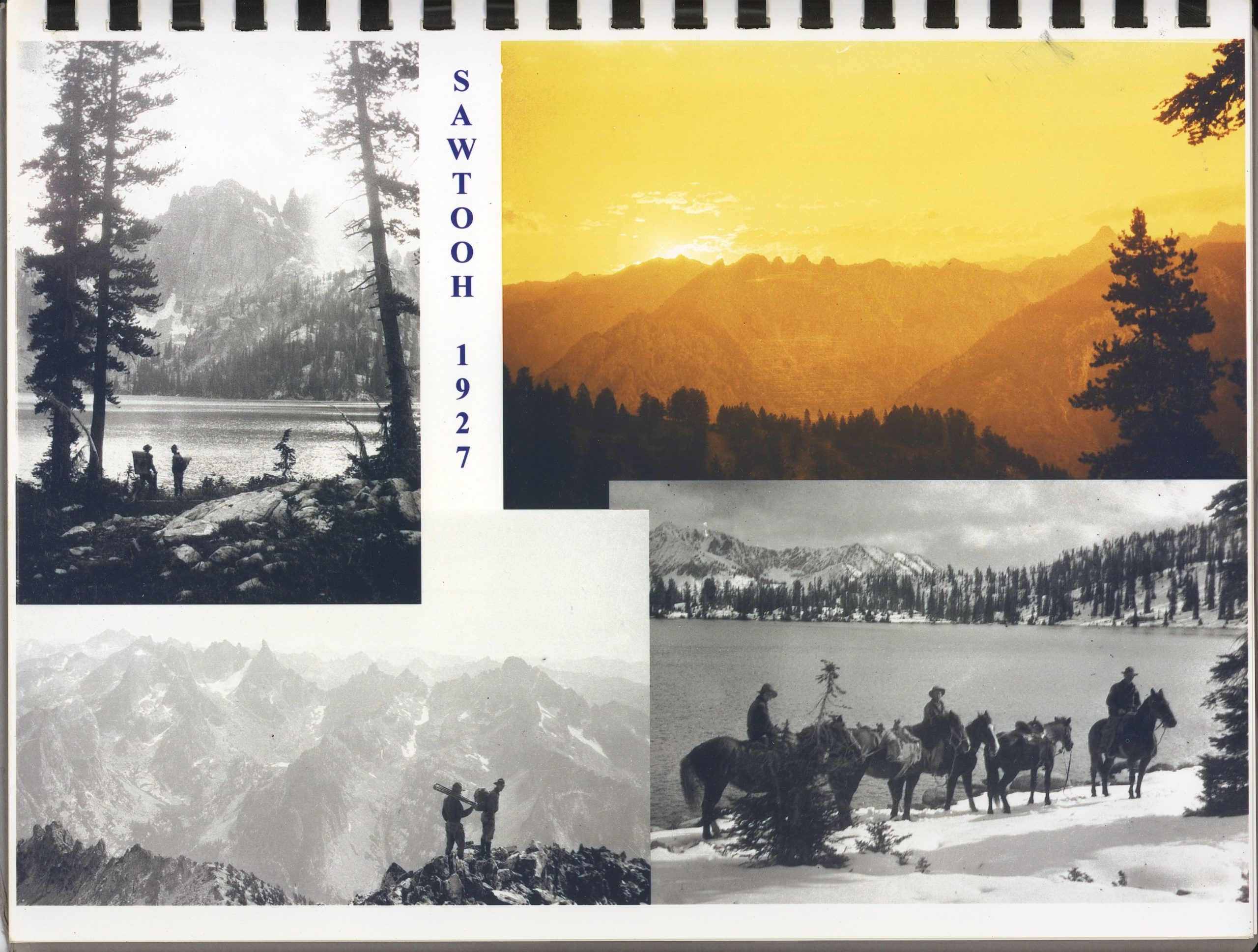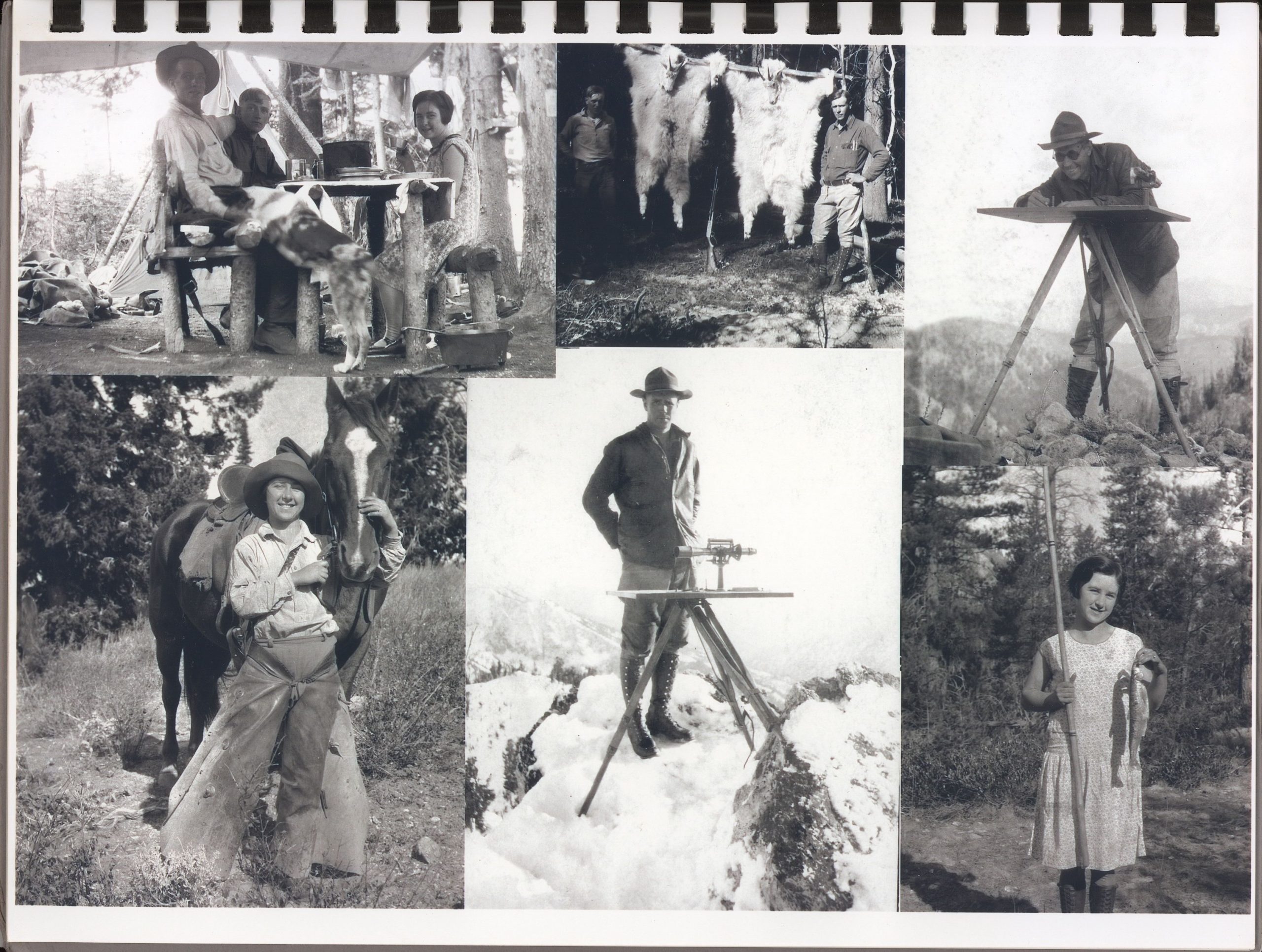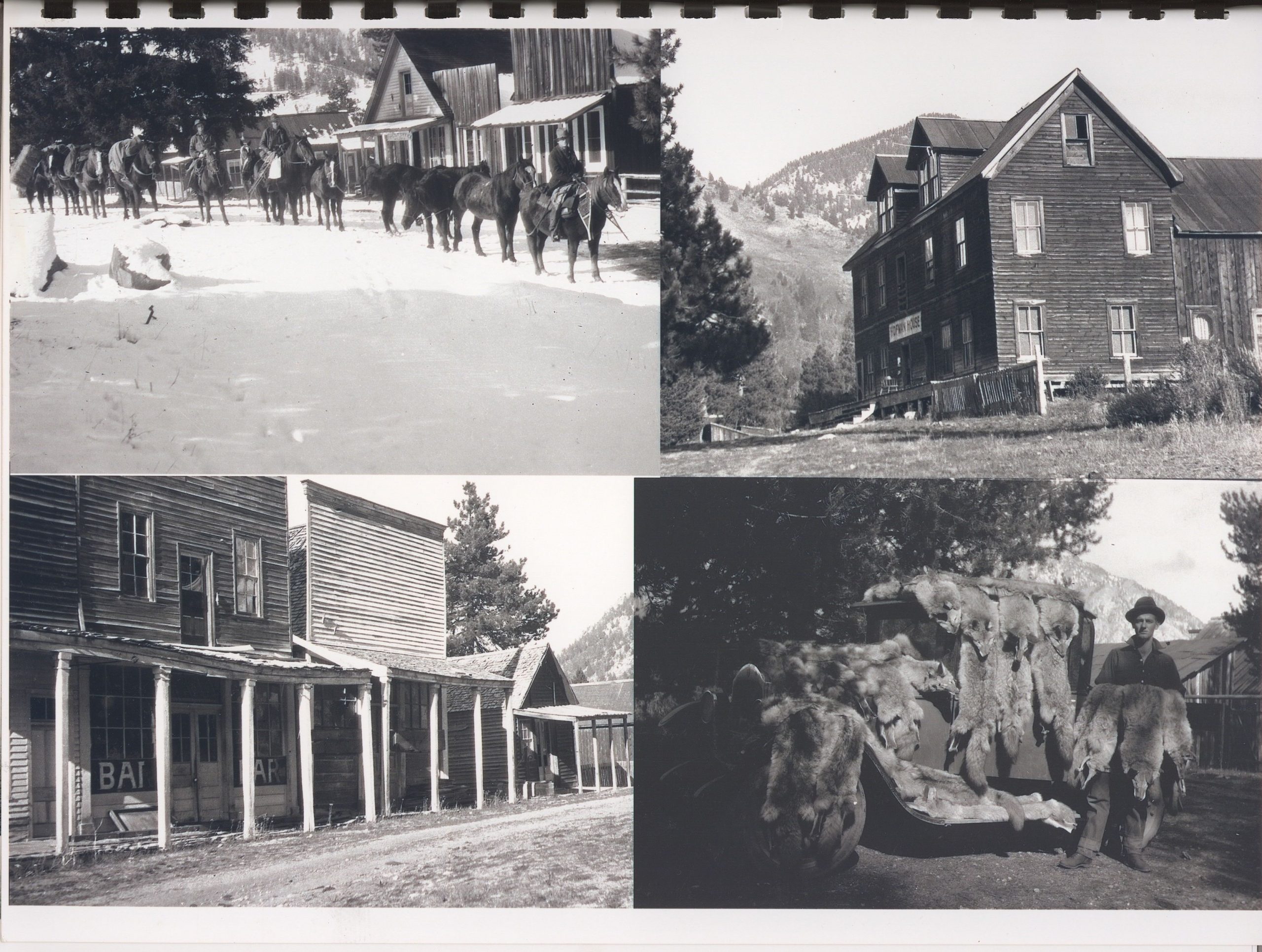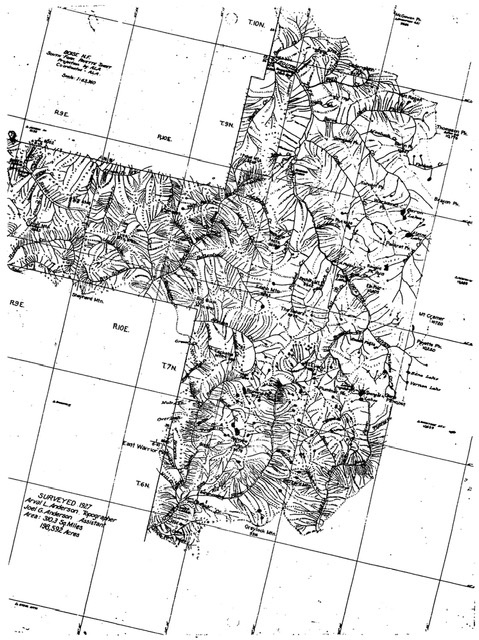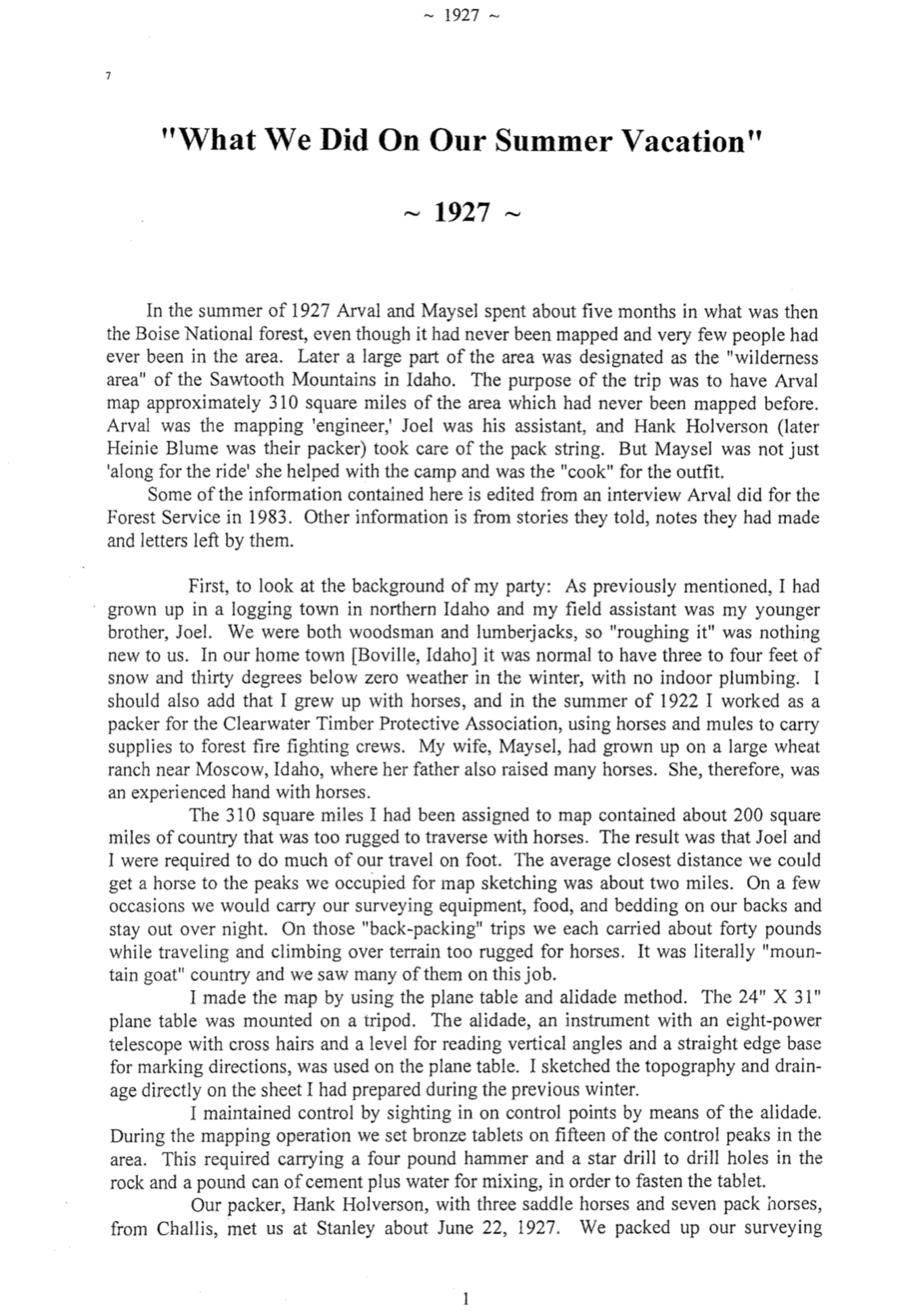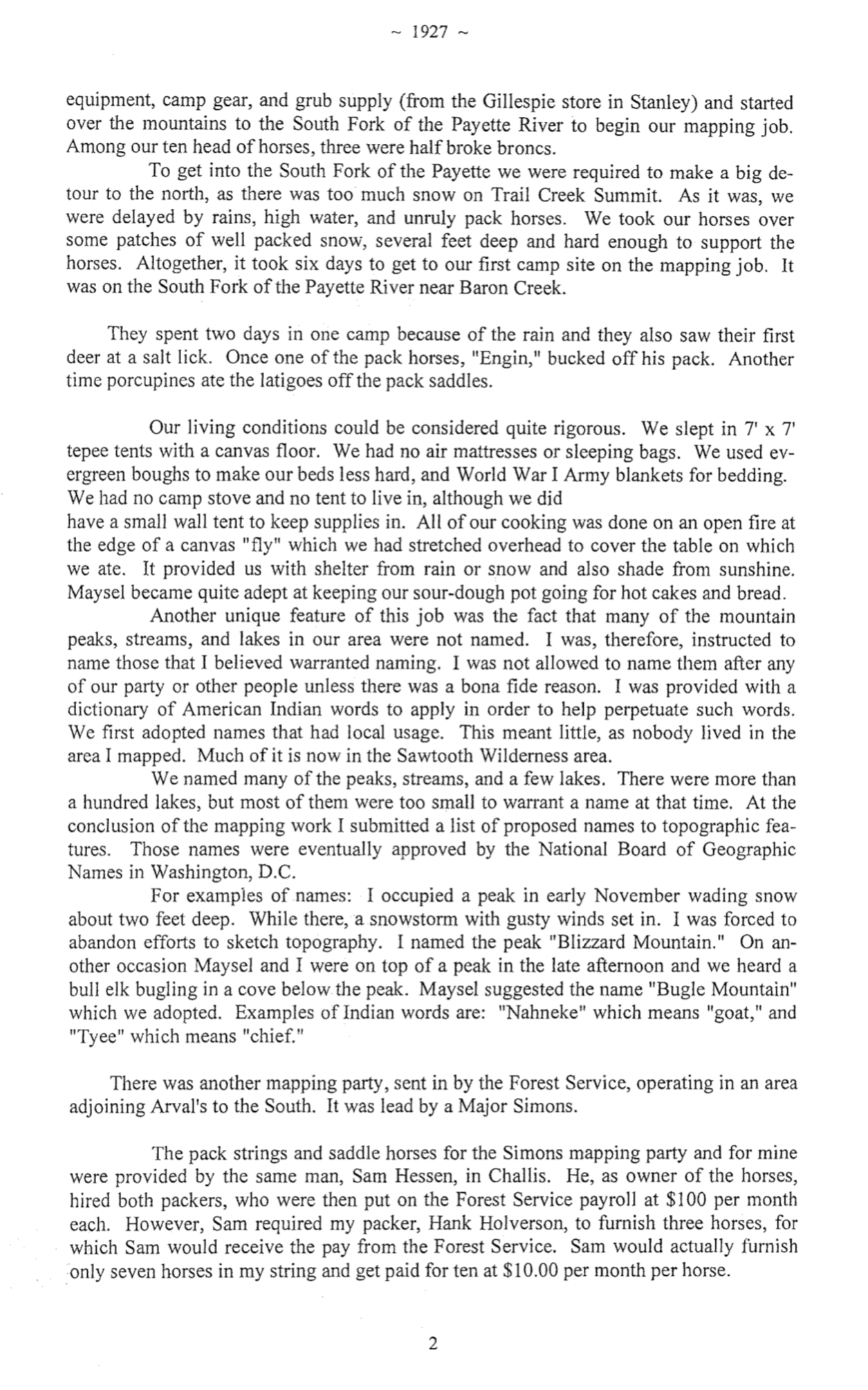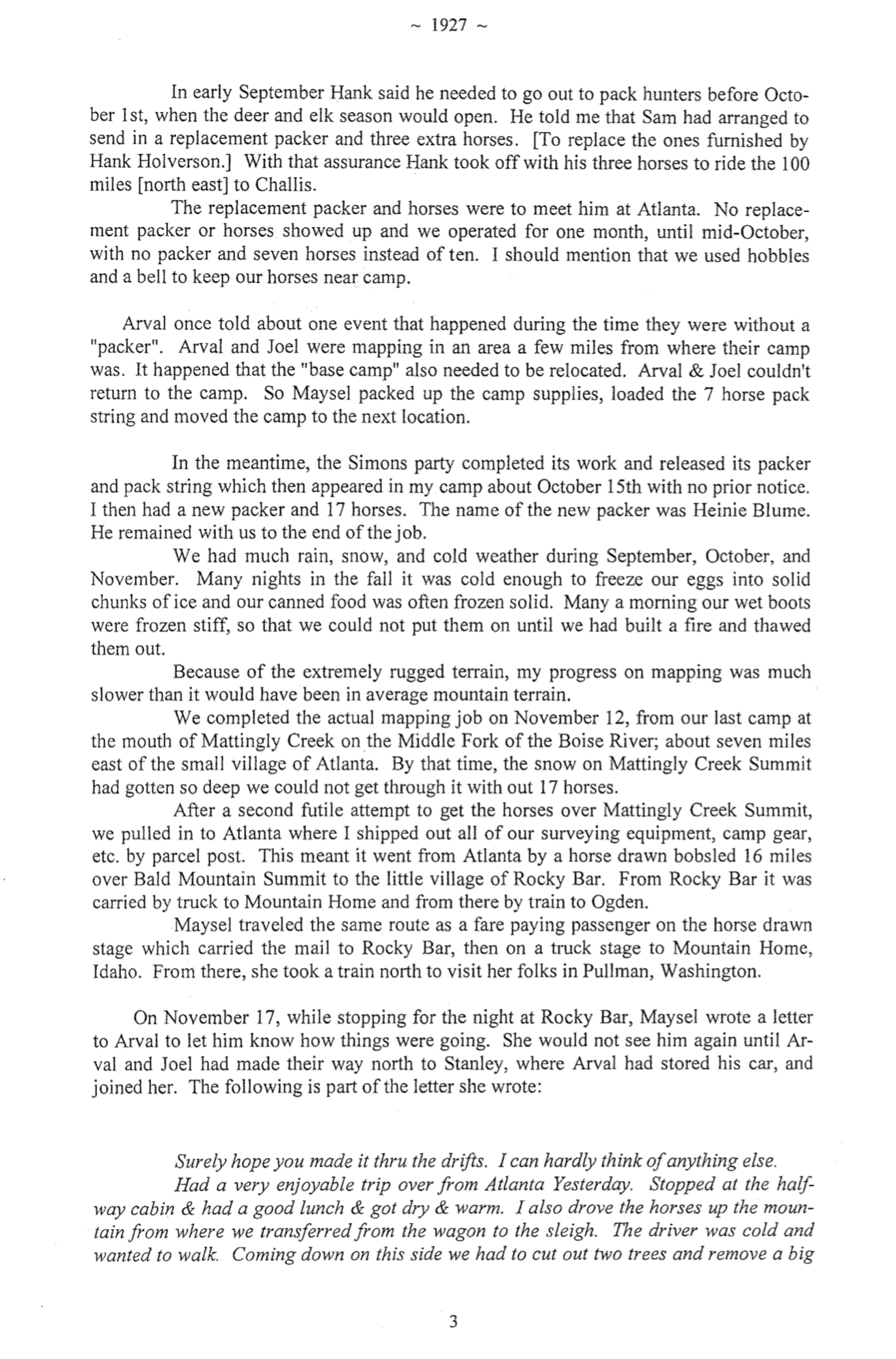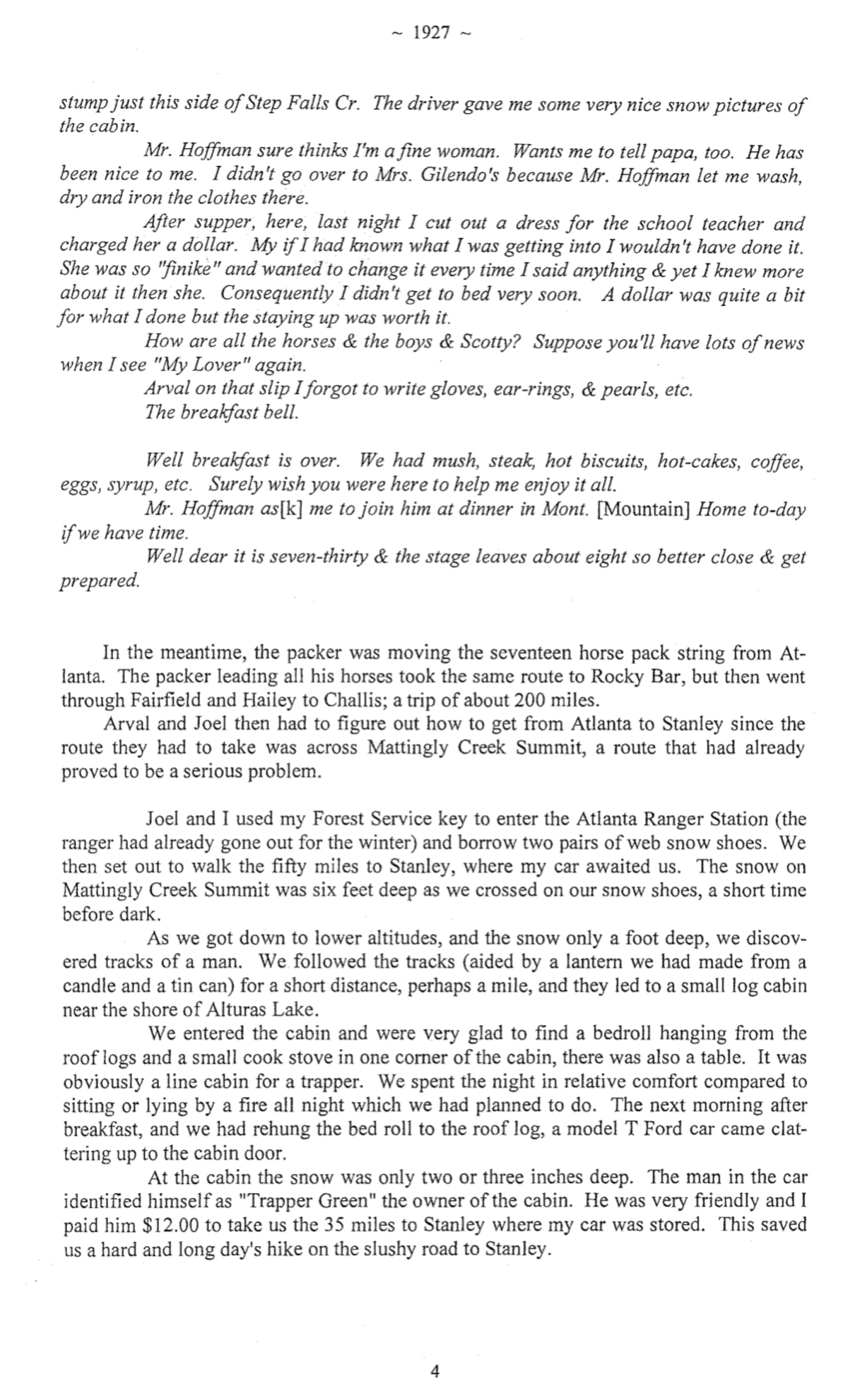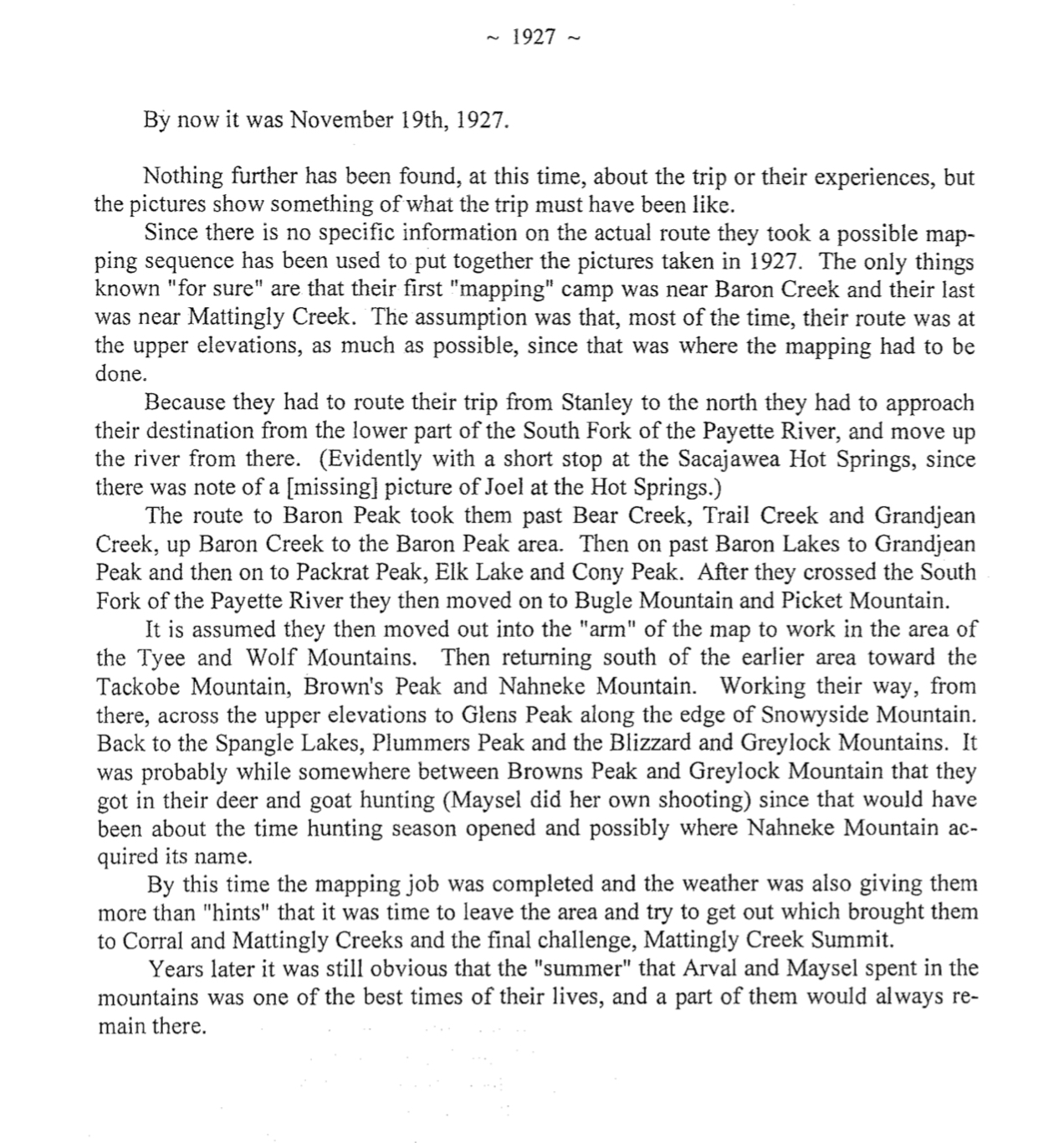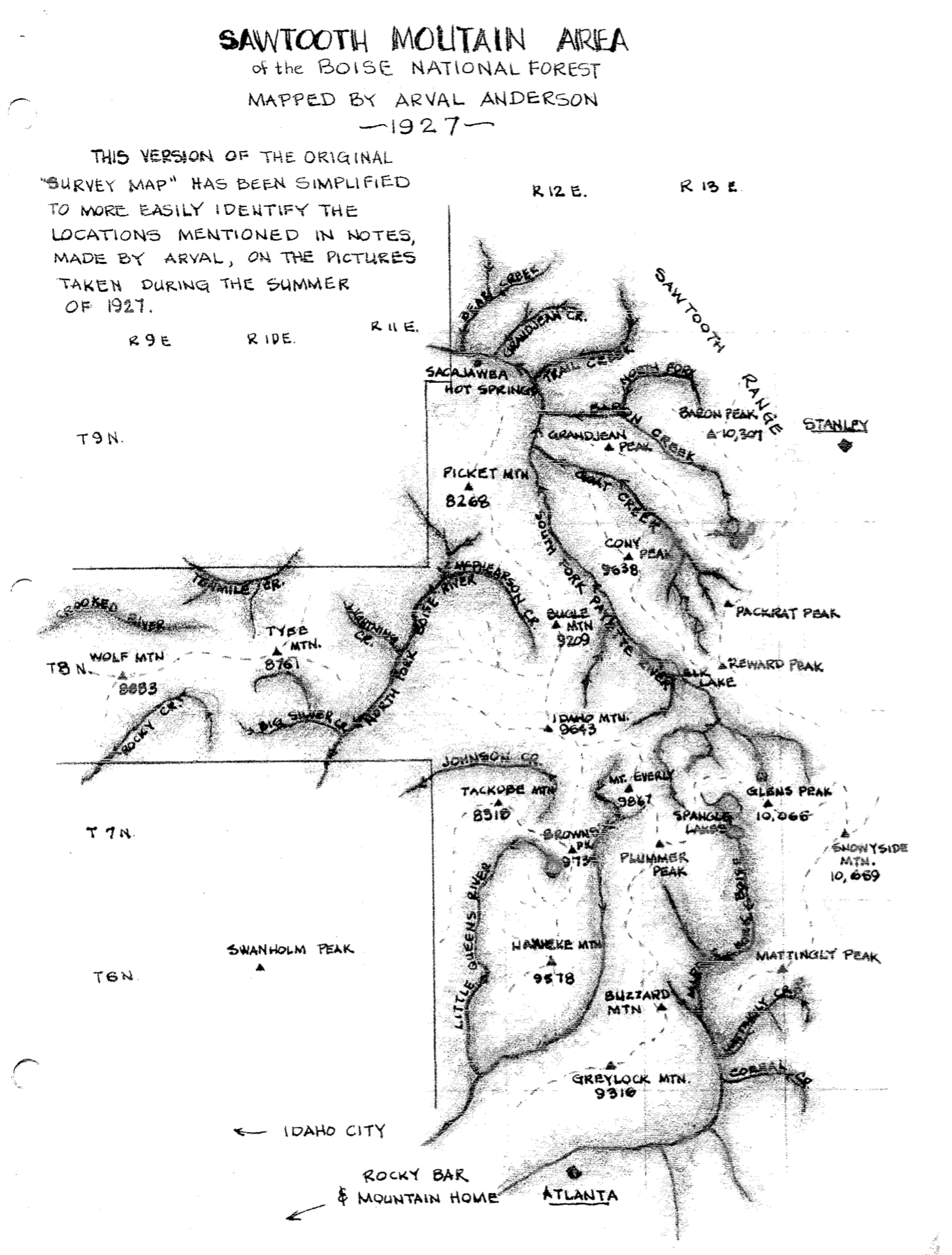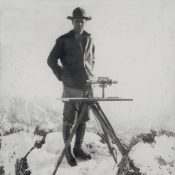
Arval Anderson, a civil engineer, was an early USFS Surveyor who was stationed in the Boise Mountains and Sawtooth Range in 1927. He is responsible for naming Tohobit, Reward and Bugle peaks among others. This entry covers a bit of Arval’s history which is quintessential Sawtooth History. There are three entries below: (1) a portion of a 1983 USFS interview, (2)”What we did on our summer vacation” by Arval Anderson, (3) an excerpt from a 1967 Summit Magazine article and (4) correspondence between Idaho climber Dave Pahlas and Arval’s family. The family has tried to have Peak 9704 in the Sawtooth Range backcountry named after Arval since 1976. This website unofficially uses the name “Anderson Peak” as Mr Anderson undoubtedly is worthy of the honor. The family has climbed the peak on numerous occasions and left a monument on the summit. The naming effort began in 1966 long before it’s location was in a designated wilderness.
(1) 1983 Forest Service Interview.
My first work that summer of 1926 was in surveys and maps and on my first field assignment I left Ogden about July 10th and traveled by train and bus to Robinson Bar which is near Stanley, Idaho. That’s where I first met Henry Shank who was Chief of the Surveys and Maps section of Engineer- ing, and my first boss in the Forest Service. I was to help him on a triangulation job in which we were to locate the geodetic positions of all the lookouts on the Boise National Forest, plus a few other peaks for mapping control. We actually started working on the Challis Forest. The Sawtooth range of mountains is located west of Stanley and marks the dividing line between the Boise and the Challis National Forests. The Sawtooth Forest lies to the south.
Shank and I started on this triangulation job and then about the latter part of July, while we were on a pack trip into the area west of Stanley, on the head of the Boise River, Henry came down with a severe cold and headache. he apparently had sinus trouble, so we returned to Stanley. Henry decided he must return to Ogden and turned the job and his car over to me. I took him the sixty miles to Ketchum (today’s Sun Valley) where he caught a train to Ogden.
Henry had hired a young fellow, named Bobby Allen, probably 17 years old, to be my assistant. He was the son of Ed Allen who was the Forest Ranger at Stanley at that time. Bobby Allen and I took Henry Shank’s Model T Ford Coupe and started out to complete the triangulation work on the Boise Forest. We occupied about ten peaks, most of them were actually lookouts, on the Boise Forest. However, Henry and I had already occupied a couple of the rugged peaks in the Sawtooth Range: Snowyside and Thompson. We also had occupied Wolf and Swanholm on the pack trip when he got sick.
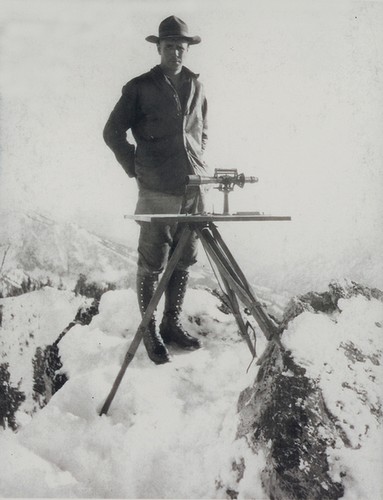
The first is a photo taken during the 1927 mapping project which shows Arval Anderson on the summit of a peak in the southern Sawtooth Mountains with his plane table and alidade. Arval Anderson Family Collection
The triangulation work required setting up a transit on each peak and reading and recording the horizontal angles between all the other desired peaks that could be seen. During the following winter in the Regional Office, I did the geodetic computations to determine the latitude, longitude, and elevation of each peak or lookout. The triangulation job included tying the network in to two Coast and Geodetic Survey second order stations. They were, Squaw Butte, north of Emett and Shafer Butte, north of Boise.
Besides locating the lookouts, the primary purpose of the triangulation was to establish control for a mapping project to be done in 1927. The area to be mapped included a total of about 600 square miles on the eastern side of the Boise National Forest. I was to map, by plane table method, 310 square miles on the northern part of this area, and another man. Major Simons, was to map the southern portion. Therefore, in addition to the goedetic computations. I prepared the plane table sheet on which I was to do the mapping in the field the following summer. About two-thirds of my area included the most rugged part of the Sawtooth Mountains. which are the most rugged in the state of Idaho.
FS: On the triangulation job. did you travel entirely by car?
AA: When Bobby Allen and I did the triangulation work. we would drive as close as we could get the car to where we were to occupy a point. If it was too far to hike and carry our instruments, we would rent horses from some local rancher. Most of the time we could make the trips within a day from where the car would be and I don’t recall that we camped out on that particular part of the work. On the actual mapping work in the summer of 1927 we had two parties on the Boise Forest. I had the northern part (310 square miles) which included the rugged country of the Sawtooth Mountains which I have described.
The summer of 1927, I made the map by using the plane table and alidade method. The 24″ x 31″ plane table was mounted on a tripod. The alidade, an instrument with an eight-power telescope with cross hairs and a level for reading vertical angles and a straight edge base for marking directions, was used on the plane table. I sketched the topography and drainage directly on the sheet I had prepared during the previous winter. I maintained control by sighting in on control points by means of the alidade.
During the mapping operation we set bronze tablets on fifteen of the control peaks in the area. This required carrying a four pound hammer and a star drill to drill holes in the rock and a pound can of cement plus water for mixing, in order_to fasten the tablet. Our method of transporta- tion was horseback and on foot. We used pack-horses to carry our camp equipment and supplies. My party consisted of a field assistant, a combined cook and packer, and my wife, Maysel. We had many interesting experiences on that job so I will highlight a few.
First, to look at the background of my party: As previously men- tioned. I had grown up in a logging town in northern Idaho and my field assistant was my younger brother, Joel. We were both woodsman and lumberjacks, so “roughing it” was nothing new to us. In our home town it was normal to have three to four feet of snow and thirty degrees below zero weather in the winter, with no indoor plumbing. My wife, Maysel. had grown up on a large wheat ranch near Moscow, Idaho, where her father also raised many horses. She. therefore, was an experienced hand with horses. I should also add that I grew up with horses, and in the summer of 1922 I worked as a packer for the Clearwater Timber Protective Association. using horses and mules to carry supplies to forest fire fighting crews.
Our packer, Hank Holverson, with three saddle horses and seven pack horses, from Challis, met us at Stanley about June 22, 1927. We packed up our surveying equipment. camp gear, and grub supply (from the Gillespie store in Stanley) and started over the mountains to the South Fork of the Payette River to begin our mapping job. Among our ten head of horses, three were half broke broncs. To get into the South Fork of the Fayette we were required to make a big detour to the north, as there was too much snow on Trail Creek Summit. As it was, we were delayed by rains, high water, and unruly pack horses. We took our horses over some patches of well packed snow, several feet deep and hard enough to support the horses. Altogether, it took six days to get to our first camp site on the mapping job. It was on the South Fork of the Fayette River near Baron Creek.
The 310 square miles I had been assigned to map contained about 200 square miles of country that was too rugged to traverse with horses. The result was that Joel and I were required to do much of our travel on foot. The average closest distance we could get a horse to the peaks we occupied for map sketching was about two miles. On a few occasions we would carry our surveying equipment, food, and bedding on our backs and stay out over night. On those “back-packing” trips we each carried about forty pounds while traveling and climbing over terrain too rugged for horses. It was literally “mountain goat” country and we saw many of them on this job.
Because of the extremely rugged terrain, my progress on mapping was much slower than it would have been in average mountain terrain. It, therefore, took until November 19th before we were able to get out of the mountains. We had much rain, snow, and cold weather during September, October, and November. Our living conditions could be considered quite rigorous. We slept in 7′ x 7′ tepee tents with a canvas floor. We had no air mattresses or sleeping bags. We used evergreen boughs to make our beds less hard, and World War I Army blankets for bedding. Many nights in the fall it was cold enough to freeze our eggs into solid chunks of ice and our canned food was often frozen solid. Many a morning our wet boots were frozen stiff, so that we could not put them on until we had built a fire and thawed them out.
We had no camp stove and no tent to live in. although we did have a small wall tent to keep supplies in. All of our cooking was done on an open fire at the edge of a canvas “fly” which we had stretched overhead to cover the table on which we ate. It provided us with shelter from rain or snow and also shade from sunshine. Maysel became quite adept at keeping our sour—dough pot going for hot cakes and bread.
Another unique feature of this job was the fact that many of the mountain peaks, streams, and lakes in our area were not named. I was, therefore, instructed to name those that I believed warranted naming. I was not allowed to name them after any of our party or other people unless there was a bona fide reason. I was provided with a dictionary of American Indian words to apply in order to help perpetuate such words. We first adopted names that had local usage. This meant little. as nobody lived in the area I mapped. Much of it is now in the Sawtooth wilderness area. We named many of the peaks. streams. and a few lakes. There were more than a hundred lakes, but most of them were too small to warrant a name at that time.
At the conclusion of the mapping work I submitted a list of proposed names for topographic features. Those names were eventually approved by the National Board of Geographic Names in Washington, D.C. For examples of names: I occupied a peak in early November wading snow about two feet deep. While there, a snowstorm with gusty winds set in. I was forced to abandon efforts to sketch topography. I named the peak “Blizzard Mountain.” On another occasion Maysel and I were on top of a peak in the late afternoon and we heard a bull elk bugling in a cove below the peak. Maysel suggested the name “Bugle Mountain” which we adopted. Examples of Indian words are: “Nahneke” which means “goat,” and “Tyee” which means “chief.”
We completed the actual mapping job on November 12, from our last camp at the mouth of Mattingly Creek on the Middle Fork of the Boise River; about seven miles east of the small village of Atlanta. By that time, the snow on Mattingly Creek Summit had gotten so deep we could not get through it with our 17 horses.
The reason for the 17 horses is another unusual incident. I pre- viously mentioned Major Simons’ mapping party on an area adjoining mine to the south. The pack strings and saddle horses for the Simons mapping party and for mine were provided by the same man, Sam Hessen, in Challis. Be. as owner of the horses, hired both packers, who were then put on the Forest Service payroll at $100 per month each. However, Sam required my packer, Hank Eolverson, to furnish three horses, for which Sam would receive the pay from the Forest Service. Sam would actually furnish only seven horses in my string and get paid for ten at $10.00 per month per horse.
In early September Hank said he needed to go out to pack hunters before October 1st, when the deer and elk season would open. He told me that Sam had arranged to send in a replacement packer and three extra horses. With that assurance Hank took off with his three horses to ride the 100 miles to Challis. The replacement packet and horses were to meet him at Atlanta. No replacement packer or horses showed up and we operated for one month, until mid—October, with no packet and seven horses instead of ten. I should mention that we used hobbies and a bell to keep our horses near camp. In the meantime, the Simons party completed its work and released its packer and pack string which then appeared in my camp about October 15th with no prior notice. I then had a new packer and 17 horses. The name of the new packer was Heinie Blume. He remained with us to the end of the job.
Now to get back to our efforts to leave the area: After a second futile attempt to get the horses over Mattingly Creek Summit. we pulled in to Atlanta where I shipped out all of our surveying equipment. camp gear, etc. by parcel post. This meant it went from Atlanta by a horse drawn bobsled 16 miles over Bald Mountain Sumit to the little village of Rocky Bar. From Rock Bar it was carried by truck to Mountain Home and from there by train to Ogden. Maysel traveled the same route as a fare paying passenger on the horse drawn stage which carried the mail to Rocky Bar. then on a truck stage to Mountain Home. Idaho. From there. she took a train north to visit her folks in Pullman, Washington. The packer leading all his horses took the same route to Rocky Bar, but then went through Fairfield and Bailey to Challis; a trip of about 200 miles.
Joel and I used my Forest Service key to enter the Atlanta Ranger Station (the ranger had already gone out for the winter) and borrow two pairs of web snow shoes. We then set out to walk the fifty miles to Stanley, where my car awaited us. The snow on Mattingly Creek Summit was six feet deep as we crossed on our snow shoes a short time before dark. As we got down to lower altitudes and the snow only a foot deep we discovered tracks of a man. We followed the tracks (aided by a lantern we had made from a candle and a tin can) for a short distance, perhaps a mile, and they led to a small log cabin near the shore of Alturas Lake.
We entered the cabin and were very glad to find a bedroll hanging from the roof logs and a small cook stove in one corner of the cabin, there was also a table. It was obviously a line cabin for a trapper. We spent the night in relative comfort compared to sitting or lying by a fire all night which we had planned to do. The next morning after breakfast, and we had rehung the bed roll to the roof log, a model T Ford car came clattering up to the cabin door. At the cabin the snow was only two or three inches deep. The man in the car identified himself as “Trapper Green” the owner of the cabin. He was very friendly and I paid him $12.00 to take us the 35 miles to Stanley where my car was stored. This saved us a hard and long day’s hike on the slushy road to Stanley. By now it was November 19th, 1927.
(2) “What we did on our summer vacation” by Arval Anderson
–Amazing Sawtooth History
(3) Summit Magazine
The following is an excerpt from an April 1967 article by Gary M. Smith in Summit Magazine entitle The Sawtooth Country of Idaho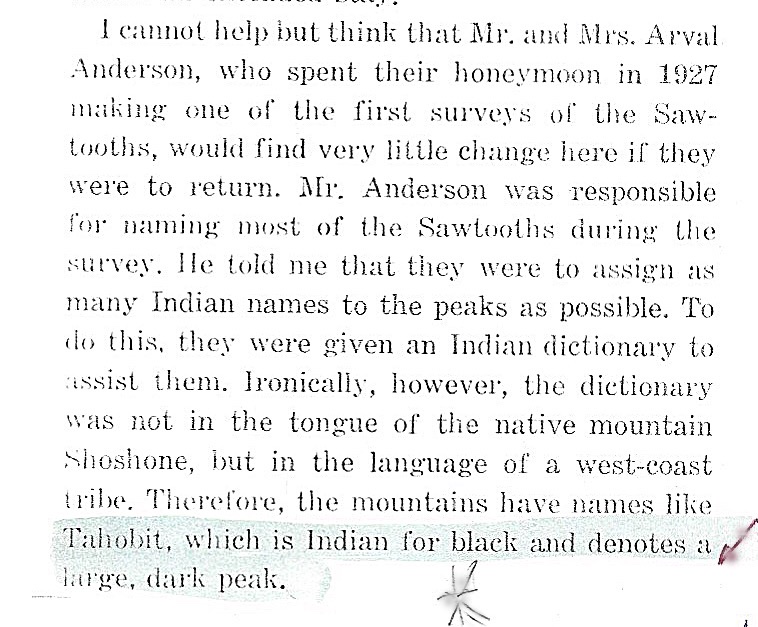
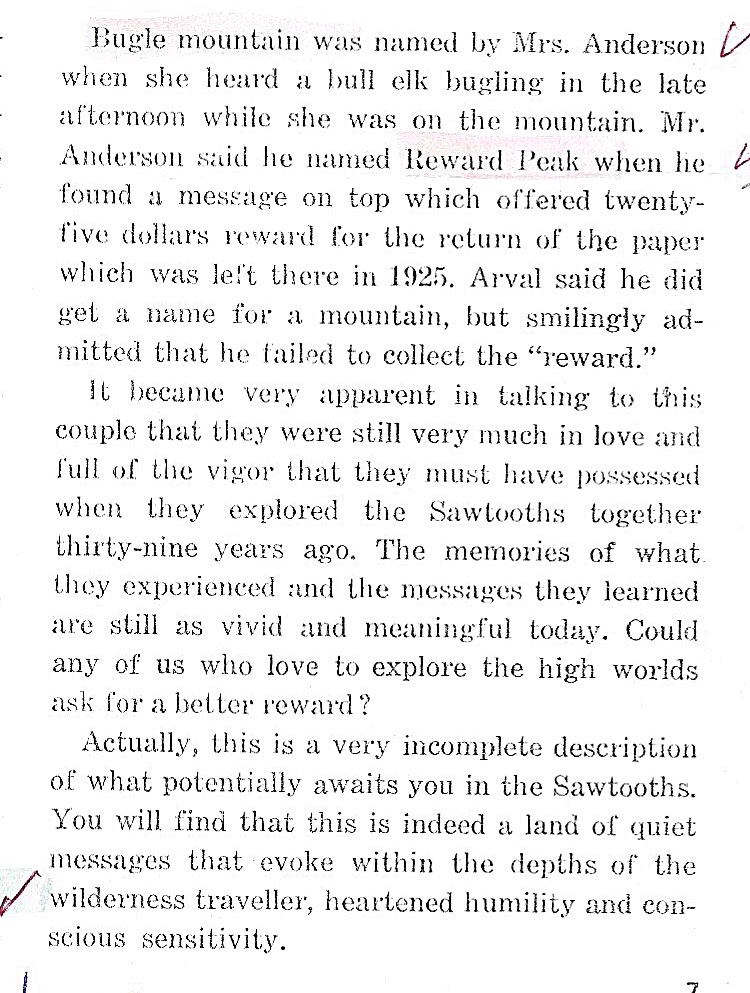
(4) Dave Pahlas Materials
Dave Pahlas provided the following historical information about Arval Anderson, who was an early surveyor and mountaineer in the Sawtooths. Anderson is credited with naming several Sawtooth peaks.
Dave reports: “On the summit of Peak 9704, I found a large stone marker proposing that the peak be named after Arval L. Anderson. This led to some Internet searching and researching, which has been rewarded with the email chain below. It was pure luck that I happened upon Mr. Anderson’s family and now I feel like I’m getting an insider view on some neat history. Anyway, I was hoping to get your thoughts on whether you think they have any chance at all of getting the peak officially named after Arval Anderson? I’ve heard that it is next to impossible to get a name changed within a Wilderness Area, but I was hoping if there was ever an exception to that rule, this one might have at least a slim chance.”
His discovery led him to Mr. Anderson’s relatives and the following email exchange which provides valuable history and demonstrates the difficulty of getting peaks officially named.
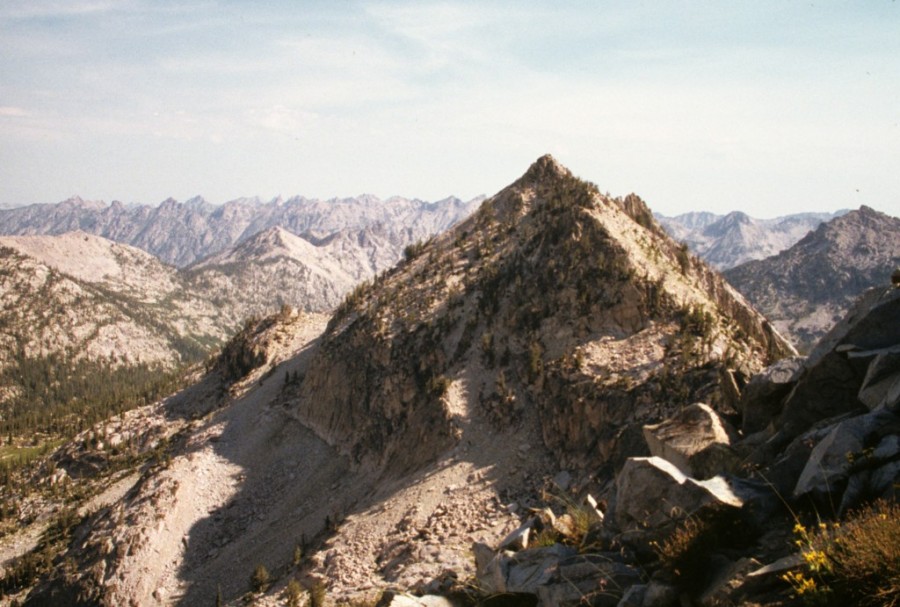
Peak 9704 (Anderson Peak) as viewed from Plummer Peak.
Dave Pahlas wrote:
Hello, I found your email address from a photo on flickr.com and I’m hoping you might be able to help me find some information about Arval L. Anderson. This weekend, I climbed a remote mountain in the Sawtooth Mountains of Central Idaho and was surprised to find a block engraved with:
“Anderson Peak”
Named in honor of Arval L. Anderson 1902-1993
He made the first map of the Sawtooth Wilderness Area in 1927.
If you know of him, I would be very interested to hear more about him and his time spent in the Sawtooths.
Regards,
Dave Pahlas
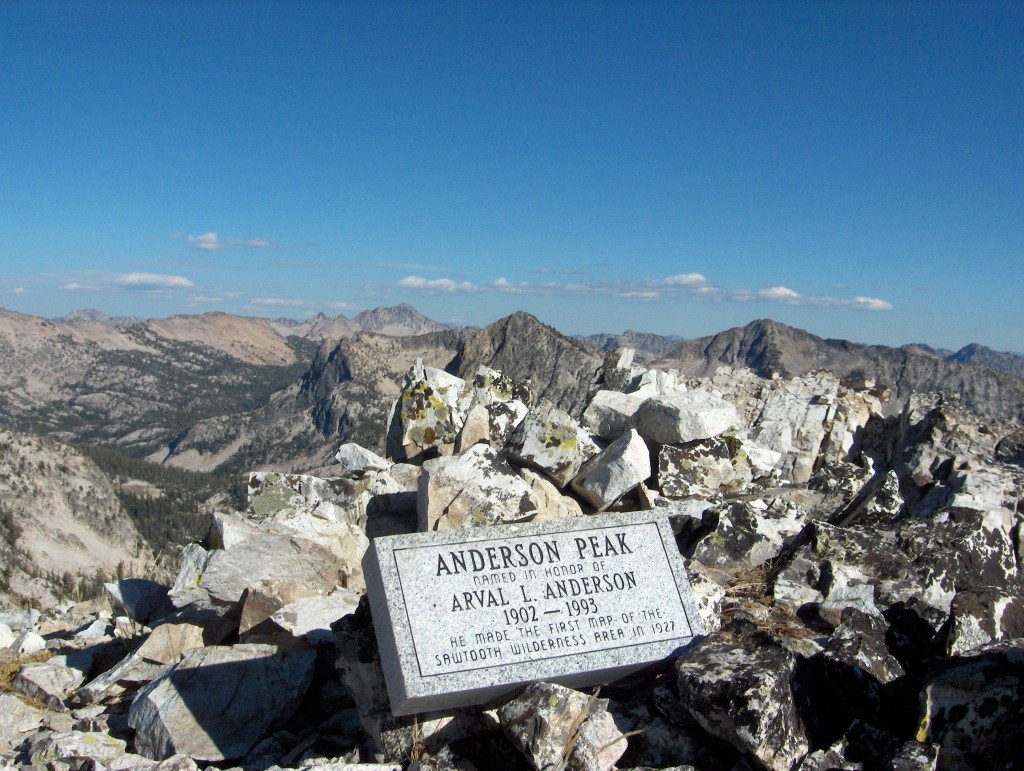
Dave Pahlas Photo
Roger Anderson wrote:
Hi Dave,
My father and I first climbed that mountain in 1952 when I was 12 years old. He told me that it was one of his favorite spots for triangulation (to locate other peaks) because you can see a large part of the Sawtooths from there. The attached, more recent, picture shows the beautiful view toward the southeast. The person enjoying the view from the top is my grandson Brandon. To the northeast (not in this picture), the Rakers are clearly visible. When dad did his survey in 1927, he did not give this peak a name because it is a few feet lower than Mount Everly to the southeast which already had its name. He used “Arval’s Peak” for triangulation because it is more accessible and has a great view of much of the Sawtooth Wilderness Area.
The other group of pictures show Arval on one of the peaks (possibly Arval’s Peak) with his plane table and alidade, and another of my mother Maysel with her horse. These were taken in 1927 while they were doing the mapping. I have other pictures from a number of trips there. I also have a copy of the autobiography done for the Forest Service that covers his entire career.
I have been to that mountain 5 times (in 1952, 1967, 1995, 1997 and 2002). I was on the top every time except 1995 which was a backpacking trip from the North End of the Sawtooths. We brought the marker to the summit where you can see “Arval’s Peak” but did not have enough time to take it closer. We took it halfway up the South Face in 1997 and my daughter Sherille’s husband Mike took it the rest of the way in 2002. The rest of us were challenged to climb the peak without carrying something as heavy as the marker. My son Keith was there every time except 1952 and in addition he was there along with his sisters in 2007. The Bells have been there in 1967, 1997 and 2002.
Keith, my daughter Kristen and I have been involved with trying to get this peak to be named “Arval’s Peak”. This is a long process and is even more difficult for a Wilderness Area. The Naming Board meets once a year and needs to have justification and signatures from other people in addition to the details on the naming petition. Keith and Kristen have gotten signatures from some of the local residents, but we have not put together a complete package. One of the rules is that we need to use first names, not last names, hence “Arval’s Peak”. We did not know that when we had the marker made. Also, his map was not the first, but was an improvement. The existing map in 1926 was not very accurate.
Regards,
Roger Anderson
—– Original Message —-
From: Donna B Sanders
To: Dave Pahlas <dpahlas@hotmail.com>Sent: Monday, August 4, 2008 4:07:32 PM
Subject: Re: Looking for information about Arval L. Anderson
Dear Dave:
That’s great!! Arval L. Anderson is my grandfather and he made the first maps of the Sawtooth Wilderness area for the Forestry Service back in 1927. He and his new bride Maysel, his brother Joel Anderson, and another fella were part of the surveying party. It was quite an amazing trip, which he documented in reports to the Forestry Service and in an autobiographical account. My cousin, Keith Anderson, has collected much of the historical information about that trip and my mother, Berniece Anderson Bell also has typed up their personal recollections of that trip. We’ve also transcribed many of the conversations we’ve had about how they named various things on their trip.
Here are some notes that I took when I visited Grandma and Grandpa in 1988 when they were still living in their house in Ogden. I found them in an old journal I kept. He explained that there were certain guidelines for naming things–i.e., you couldn’t name anything after a living person [unless that was the already established landmark] and that, wherever possible, they were to choose names that the Native Americans had used or that were Native American words.
Names and Derivations of Grandpa’s Sawtooth Survey
Wolf Mountain — Where Grandpa and Uncle Joel saw some wolves
Tyee — Indian word for Big and Fat. Named because it was a big, fat mountain
McPhearson Creek, McLeod Creek and McKay Creek — were already named after sheepherders in the area.
Big Buck Mountain — was named after the Big Buck Grandpa killed which is hanging in the basement.
Edaho Mountain — is named after the Indian word for “Light on the Mountain”
The Rakers are named for how they look: the raker blade of a logger’s saw.
Reward Peak was so named because on the top they found a pile of stones with a paper under it. The paper said “There is a $25 reward for whoever returns this paper to: ” Then there was an address. Grandpa wrote to them, but they never wrote back.
They saw a packrat at Packrat Peak.
Bugle Mountain was named after the elk bugling in the valley below.
Warbonnet Peak looked like an Indian warbonnet.
Blizzard Mountain was so named because they had a terrific snowstorm while they were there.
In 1967, Grandma and Grandpa took all their kids and grandkids [including me] on a backpacking trip to celebrated the 40th anniversary of their surveying trip. It was an amazing adventure and we have many photographs of that trip. My mom and likely Keith have many of the photographs of Grandma and Grandpa’s 1927 original trip as well. My nephew Bryan Wesley Bell may have digitized some of these photos as well.
Attached are a few photos from our 1967 trip. I’ve also attached a picture of Grandma and Grandpa with us kids so you’d know what he looked like. He was wonderful person, very even-tempered, kind-hearted, wise and extremely capable. After he retired from the U.S. Forest Service, he was hired by the Taiwanese Government to be the civil engineer to build their country’s first highway.
After our Grandfather died, some of us climbed up Anderson Peak to place the marker you found. His son, Roger [my uncle] worked with the authorities to officially name that peak after my Grandpa. You can talk to him or Keith about that process. Several of us make the trek up there every year or two to spend time in the beautiful Sawtooths. I’m also cc’ing this email to my cousin Keith, my uncle Roger, my Mom and my brothers [Bruce Wesley Bell, Bryan Arval Bell] who may have other things to add.
With warm regards,
Donna Bell Sanders
Date: Sat, 13 Sep 2008 14:14:18 -0700
Subject: Fw: Information on Arval Anderson
Hi Dave,
I just realized that I do have a copy of the letter that I sent to Vaughn Stokes in 1996. It has a summary about my father. It is attached. While I was working with the Forest Service/U.S.Geological Survey, they suggested that a different peak might be easier, one outside the Wilderness Area or one not so close to another peak (Everly) that already had a name. I said no; it had to be this one.
I did not tell them of the experience that I had had with my father when we were there in the 1950s. He took me to this peak and told me that it was one of his favorite triangulation points because the view is so vast. You know that Dave because you have been there. He picked up a rusty tin can, pulled out a small slip of paper and wrote on it “Roger’s Peak” and said, “I am going to name this peak for you” and explained that he couldn’t really do that, but it was just between him and me. He put the paper in the rusty can and placed it under a rock on top of the peak. What a great dad. There could be no other peak to honor him. For a little more information–within our family, we call the small lake at the base of the peak “Bell Lake.”
Regards,
Roger Anderson
—– Forwarded Message —-
From: Roger Anderson
To: Dave Pahlas
Cc: Keith
Sent: Saturday, September 13, 2008 11:47:47 AM
Subject: Information on Arval Anderson
Hi Dave,
I was just looking through the information that I have on my dad and the Sawtooths. I have the following items:
1) Pages 4 thru 9 of the “Forest Service History Series, Arval L Anderson, Interviewed by Al Brady, May 1983”. This covers in great detail the Summer of 1927 that my dad and others spent mapping the Sawtooth Wilderness Area.
2) A copy of the map that my dad had made in 1927. My sister Berniece (Donna’s Mother) may have the original.
3) Pictures that include: Arval, me and my ex-wife sitting on top of “Arval’s Peak” in 1967. A beautiful picture of “Arval’s Peak” taken from Mount Everly. It was taken from high enough that you can see the lake just below the peak. And other pictures.
4) A copy of the first request to name this peak that I had sent in 1996 to Vaugh Stokes, the Forest Service Regional Engineer for Region 4 and his response.
The problem is I need to wait until Wednesday of next week to scan these documents. My wife is away and she is the scanner expert. Did you get my last e-mail that had pictures attached? I got at least one date wrong. We were there in 2003 not 2002. Were you able to open the pictures?
Regards,
Roger Anderson
Vaughn Stokes May 19, 1996
Regional Engineer
U.S. Forest Service
324 25th Street
Ogden, Utah 84401
Dear Sir,
This letter is written to request that one of the peaks in the Sawtooth Wilderness Area be named for Arval L. Anderson.
Arval was born in 1902 in Northern Idaho and died in 1993 in Colorado Springs, Colorado. During his life, he worked for the Forest Service, was an Officer in the Military and together with his wife Maysel, produced three children and adopted a fourth. He was my dad and a wonderful father to all four of us.
Arval graduated from the University of Idaho in June of 1926 with a degree in Civil Engineering. He joined the Forest Service and was given an assignment to make the first U.S. Forest Service map of the Sawtooth Wilderness Area northeast of Boise, Idaho.
During 1927 Arval, Maysel and Arval’s brother Joel lived and worked in the Sawtooth Wilderness creating a map. A copy of that map is enclosed. He occupied most of the major peaks and named many of the peaks, streams and rivers.
When I was in my teen years in the 1950s, I visited the Sawtooth Wilderness for the first time with my dad. He took me to a peak which is located in the center of the wilderness area. This peak is a location used by my father as a triangulation point for creating the map. From that point, you can see many of the other peaks including The Rakers, Mount Everly, Brown’s Peak and others as far away as Glens Peak and Mount Cramer.
Again, in 1967, my father and I climbed the peak. This was during a family vacation when Arval and Maysel took their children and grandchildren for a 5-day camp-out at the head of the Queen’s River. Our campsite had a beautiful view of the peak as the sun arose in the morning.
The peak is not accessible by trail and can only be climbed from the Southeast Face. My dad loved this peak because of its central location and beautiful 360-degree view of the Wilderness Area. The height of this peak is 9,704 feet, which is comparable to other peaks in the Sawtooths. It is located one-half mile south of Arrowhead Lake.
In 1995 my son Keith, my daughter Sherille and I, along with their spouses and other friends took a 6-day backpacking trip into the Sawtooths. We attempted to climb the peak on a one-day side trip from Benedict Lake. We did not all make it to the top, but two of our party did and took panoramic pictures from the top. I have enclosed one of the pictures which shows the view eastward looking back toward Mount Everly and extending northward to Blacknose Mountain. The other picture is a view of the peak taken from the ridge north of Mount Everly which divides the Queens River drainage from the Benedict Creek drainage. This peak does not have a name. I am requesting that it be given the name of “Anderson Peak” in honor of my father.
Arval worked for the Forest Service from 1926 until he retired. His jobs included Regional Engineer for Region 4 (Ogden) from 1938 until 1959 and Regional Engineer for Region 1 (Missoula) until he retired in 1962. His work for the Forest Service was noted in a “Forest Service History Series” publication made from an interview by Al Brady in 1983. A copy of the portion of that interview relating to his Sawtooth experience is enclosed. He was a retired Colonel in the U.S. Army and served active duty during the 2nd World War.
Yours truly,
Roger Anderson
